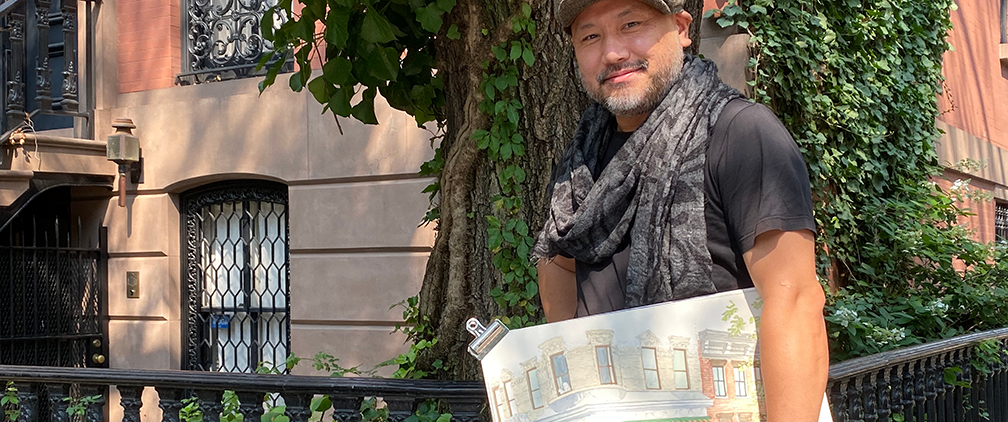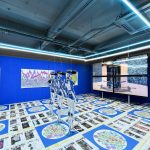Conversations | Kazuya “Kaz” Morimoto On Outdoor Painting and Making a Career Out of Your Art
“Since I started painting in the neighborhood cityscape, through having conversations and communicating with local people, I realized that my cityscape paintings make people happy and mean a lot to locals. It totally changed my approach to my art.”
Visual artist Kazuya Morimoto devotes most of his time to painting the streets of New York City, especially historical preservation areas like Greenwich Village. An alumnus of The Art Students League of New York, his practice is based in and revolves around his community, and the arc of his life as an artist offers much guidance to anyone trying to sustain their art practice.
NYFA: You’re from Japan. Tell us about coming to New York and what that process was like.
Kaz Morimoto: In Japan, I didn’t go to art school. I studied sociology, but my passion was always to create something ever since I was a kid. I’m from a very countryside place in Japan, a place called Okayama, so we didn’t even have an art school. I took a local watercolor class and used to go to sketch with my friends. Once, after I started working, I met this guy named Mr. Makoto Arimichi, who came back from San Francisco and opened a studio for people who like to create art and gather with other artists. Sometimes we spent whole nights creating and talking about art, then slept at work. It was quite a rare opportunity for us to have such a place in my hometown. So after maybe two years of working with him, he told me that I should go abroad to study, or even just create something on my own because Japan is very conservative and you have to take certain steps to become an artist. He recommended I go anywhere outside Japan, so I picked New York.
NYFA: For how long were you at The Art Students League?
KM: About twelve years. First I took painting for four years, then printmaking, then sculpture. It was a certificate program for students.
NYFA: Was there a particular teacher there who really influenced you?
KM: My first instructor, Frank O’Cain, taught me all the basics. I learned from him only one year, but I absorbed all the essence from him, so that was quite… the base part of me. He’s a great teacher. But I mostly learned from Chelsea galleries and museums. This is the greatest thing about New York City. When I was at The Art Students League, working on conceptual pieces, I never expected people to understand my projects, and I was making art just for myself. It was quite tense and I was totally in my own world, but it was important to make myself clear as an artist.
Since I started painting in the neighborhood cityscape, through having conversations and communicating with local people, I realized that my cityscape paintings make people happy and mean a lot to locals. It totally changed my approach to my art. I enjoy making art for people and working in the community. It doesn’t mean that I compromised my attitude toward my art, but making art with the community opened me up to other possibilities.
NYFA: When did you start painting outside?
KM: I started to paint streets in 2007. Actually, I had made ink sketches daily since I moved to New York in 2000, but after September 11, I was distracted by police a couple of times, so I stopped sketching for a while. Some people thought I was suspicious because I was drawing street signs, fire hydrants, garbage cans, tunnels, and so on. I was trying to collect elements of the streets of New York, but it made people nervous at the time. When I came back from my first trip to Europe in 2006, I was so inspired by the landscape and old European cityscapes. The same summer, I received a travel grant for the next year. I knew the next time I was in Europe, I wanted to make sketches with watercolor. The trip was six months: I went to Spain first, then Amsterdam, Belgium, Paris, and Italy. When I came back to New York, I thought maybe it’d be fun to sketch old parts of it with watercolor as well. So, that’s how I started. Especially in Greenwich Village, since it’s a nice, old, and historical neighborhood like those of Europe.
NYFA: You had an exhibition at the Jefferson Market Library that looked great.
KM: Thank you very much! They really appreciated having local artists making the art, since Greenwich Village was originally a bohemian neighborhood, but not anymore. They liked my cityscapes, so they asked me if I wanted to show my work to the locals, and I decided to do it.
NYFA: How does it feel interacting with people or finding a spot? What’s been your experience of working outside?
KM: Painting outside is quite popular in Europe. Every time I go there, I meet people who are painting outside. But in New York, I think people do more contemporary art, so normally people work in a studio. I don’t see many people painting outside, but it’s fun. I like it. I like talking to people, and in this neighborhood, people are very friendly. The energy is different in each neighborhood. First I was painting in the Upper West Side, where I used to live, then Lower East Side, Soho, Nolita, but the West Village is very special to me.
NYFA: Do you have a side job, or is this your job?
KM: No, this is my full-time job. I’m so happy and feel very lucky that people like my art.
NYFA: That’s great. You’ve also published a book, right?
KM: Yes, in 2017! Voyage d’un peintre japonais en Europe. It was published by a French publisher. The book received a prize from the Michelin Foundation. It was quite an experience. It was about my sketch trips in Europe from 2006-2016.
NYFA: Do you have advice for immigrant artists who want to make a living out of their art?
KM: Yes, I think it’s quite a difficult kind of living for any type of artist, to be honest. You have to be lucky. But also, it’s important to believe in yourself, follow your passion, and work hard. You never know where and how you’ll meet people and get opportunities. I was not planning to be a street painter. For the first few years, I was just painting for myself. Then, people started asking me if I wanted to sell my work, or if I wanted to paint their place. In the beginning, I wasn’t even accepting any of those offers, but since people were so interested in my paintings and so convincing, I started selling prints, watercolors, and making custom paintings for them. Now, this is my full-time job. I like doing this, I recommend artists to just keep doing your favorite thing and stick to it. I sometimes have exhibitions, but most people commission me to paint their favorite location including their family, and pets, things like that, with very intimate, sentimental values for them.
– Interview Conducted by Alicia Ehni, Program Officer and Kyle Lopez, REDC Fellow
This post is part of the ConEdison Immigrant Artist Program Newsletter #132. Subscribe to this free monthly e-mail for artist’s features, opportunities, and events. Learn more about NYFA Immigrant Artist Mentoring Program.





